  |
Timothy Singer and Matthew Basinger present key findings and lessons from a survey of jatropha farmers in Koulikoro, Mali. |
| The most significant finding of the survey was that 75 per cent of farmers experience food insecurity during the year. The survey allowed researchers to explore where farmers turn for food and income during months of shortages and to explore what types of local efforts are in place to fight shortages. Other key findings concerned challenges to jatropha production and access to water. | |
| Tim Singer was a research fellow with Mali Biocarburant September 2009-June 2010 and is now studying at Bryn Mawr College in Pennsylvania in the United States. Matt Basinger is a post-doctoral fellow with the Earth Institute at Columbia University, New York, United States. | |
The soils of Koulikoro, Mali - a deep iron red, sandy, and dry - are an unlikely place for biofuel feedstock growth. An administrative district of 150,000, Koulikoro is only 60km east of Bamako, Africa's fastest growing capital, but life and economy are hardly bustling. With villages dispersed along rural roads, only 66 per cent of arable land is planted in Koulikoro, even as 80 per cent of the population depends on agriculture, staple crop production, as their principal source of income.
Since 2007, Mali Biocarburant SA, a Dutch-Malian joint biodiesel firm, has been promoting the planting of jatropha, a durable, non-edible, oil-seed bearing shrub that grows natively in Mali, as a means of helping to jumpstart the economy of Koulikoro and produce biodiesel blends that will be sold in Mali and abroad. In April 2008, Mali Biocarburant set up a 2,000 litre/day biodiesel plant in Koulikoro ville with the plan to buy all of its seeds from local farmers in Koulikoro and nearby areas in Mali where the ecological conditions are favorable for production (at least 800mm/yr rainfall).
Across Africa, biofuel firms have been investing heavily in jatropha production but with largely poor results. For D1 Oils, who saw a joint-venture in Malawi (200,000ha) and Zambia (15,000ha) with BP collapse in late 2009, the issues were of corporate structure and poor agronomic knowledge. For the Kenya Jatropha Energy Limited project, challenges have focused on local land rights (always a tricky issue) and environmental concerns, as the Italian-backed firm plans to cultivate 50,000ha of land in the Dakatcha Woodland, an internationally-known safe-haven for rare birds in southern Kenya.
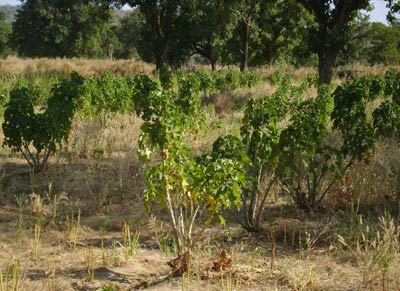 |
|
A field of sesame and jatropha in Dinandougou,
Mali. Intercropping systems are promoted in an
effort to improve overall field fertility and
productivity
© Timothy Singer |
The vigorous opposition seen in Kenya and the unfulfilled promise of D1 are exactly the types of pitfalls which Mali Biocarburant has sought to avoid. To help navigate these challenges, groups like the Roundtable for Sustainable Biofuels and the Partners for Euro-African Green Energy have published guidelines of economic and social considerations, which firms can take to engage local shareholders that may be helpful to a successful biofuel venture.
From October to December 2008, one of us (TS), along with a team of Malian technicians agricole (field staff) from Mali Biocarburant, conducted a socio-economic baseline survey of a sample of 200 jatropha farmers in Koulikoro who began working with Mali Biocarburant the previous year. Known locally as animateurs, the field staff recruits farmers and provides technical assistance in field management specifically for intercropping jatropha. The goal of this study, which utilized focus groups in 12 villages and included over 50 individual interviews as well as field visits, was to understand the start-of-project challenges that farmers and their communities face in undertaking the cultivation of jatropha. The baseline survey was constructed using an easy to follow point system called a wealth ranking analysis, intended to help identify where farmers faced the greatest challenges to production and where Mali Biocarburant could engage in social investments in the short and long run to best partner with the farmers of Koulikoro.
Key findings
The survey gathered baseline data for ten sectors of development. Across some of the sectors - food security, agricultural tools, land stewardship, water access - the effect of Mali Biocarburant's involvement could be seen in the relative short term. For other sectors - energy, road, education, health access - any effects may be manifest in the longer term and will require reaching outside of the biofuel/agricultural sector to help realize local impacts. For both sets of variables, sharing results and methods will serve to help future biofuel projects gauge the types of information they can gather at the start of projects to become more socially-minded firms.
| Category | Points | Variables |
|---|---|---|
| Age and Gender | 10 | Diversity of farmer age and gender |
| Land assessment | 10 | Ownership, fertility |
| Water access | 10 | Sources - home and farm |
| Agricultural tools and transport | 10 | Available agricultural resources |
| Energy use | 5 | Energy use and access |
| Road access | 10 | Road quality and access |
| Health access | 10 | Health care professionals and access |
| Educational access | 10 | Access, facilities, faculty |
| Food security | 15 | Food security and income sources |
| Village economy | 5 | Local economic activity |
| 100 points total | ||
The most significant finding of the survey was that 75 per cent of farmers experience food insecurity during the year. Prolonged food shortages (any period of greater than two years) can cause permanent physical and mental damages to individuals and thus are a critical issue for sustainable biofuel production. One of the key recommendations of the Roundtable on Sustainable Biofuels Version Zero is that biofuel production not impair food security. As such, Mali Biocarburant has attempted to support planting on marginal lands and in intercropping systems. Further, the survey allowed researchers to explore where farmers turn for food and income during months of shortages and to explore what types of local efforts including storing grains and communal farming are in place to fight shortages.
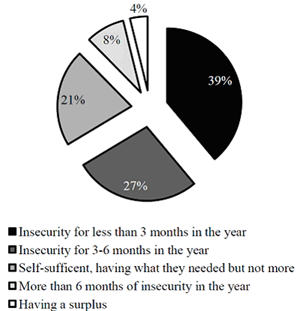 |
| Figure 1: Farmer food security |
In promoting intercropping systems between biofuel and subsistence crops, it was found that farmers are increasingly identifying fields with jatropha planted as "individually" owned versus "family-owned." In Mali, the responsibility for cultivating a parcel is traditionally shared among family members with the head of the family, usually the oldest male, making final decisions about land use. Biofuel production does not change this ownership model per se, but the act of planting jatropha - a perennial - is seen to designate a specific manager to the parcel of land. Farmers were asked how their jatropha fields were classified - family versus individual - before and after planting. Before planting, ninety-four percent of farmers identified their land as family-owned jatropha and only six per cent claimed individual ownership. After planting, 37 per cent classified their land as family-owned while 60 per cent said the land was now individually owned.
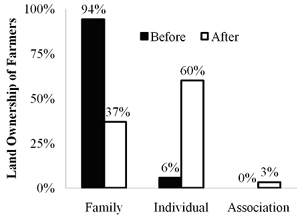 |
| Figure 2: Change in land ownership (family, individual or association) after planting jatropha |
The importance of intercropping and sound land management makes having a designated individual for each jatropha field an important risk-averse measure. Biofuel firms should take measures to account for each farmer and each field - Mali Biocarburant uses a Geographic Information System database, so that the firm can lend technical assistance, and as importantly, help protect farmers from risk prone choices such as mono-cropping schemes that can be a challenge to food security.
A second key finding concerned farmers' perceptions of challenges to production. Planting Jatropha requires less labour than most cereal or cash crops produced in Koulikoro. That said, in intercropping systems, the ability to plant both jatropha and a subsistence crop is greatly constrained by the availability of resources and labour. Farmers were asked to rank a list of resources (or absence of) in order from 1-4 of which posed the greatest constraint to jatropha farming.
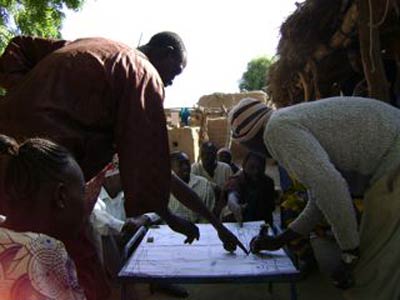 |
|
Mali Biocarburant Animateurs conduct a community
mapping exercise with jatropha farmers
© Timothy Singer |
Over 60 per cent of all respondents cited deficient tools, water and fertilizer among their responses and thirty-eight percent (38 per cent) reported a lack of water as the greatest inhibiting factor in jatropha production. The survey did not include soil sampling for nitrogen (N), phosphorus (P) and potassium (K) or loam quality. Measurements of farmer perception of soil fertility were made and only 13 per cent of farmers reported that a jatropha field they farm had "good" fertility as opposed to 86 per cent of farmers who reported having a jatropha field with poor fertility. An empirical study will need to be conducted to confirm how these perceptions compare to actual N-P-K-loam values, but the responses of farmers put their opinions on challenges to production in the forefront.
The third key finding concerns water access at the farm and village level. The challenges of water shortages in developing economies are critical and biofuel projects must be highly cognizant of local water resources when assessing the feasibility of production. The standard metric for evaluating water access in villages is to count the number of "improved water sources" - a treated potable source that can deliver five litres of water a day for up to 500 people - per population.
In sub-Saharan Africa, just 61 per cent of rural populations have access to at least five litres of water a day. In the villages where Mali Biocarburant works, it is clear that water access is a huge challenge both for domestic and agricultural uses. The baseline survey counted the number of improved water sources for each village but found that many such improved sources failed to meet the needs of the village.
The Sphere Project recommends a maximum of 500 people per improved water source (hand-pumped) in their natural disaster response guidance. When considering water-borne illness and need for water sources that are actively monitored and maintained as well as readily accessible, one water source per 500 people becomes entirely inadequate. The average family size in Mali is about eight people (nuclear families) and it is likely that six to eight families will share a "concession" - a central space encircled by each family's home. Therefore, Mali Biocarburant determined that a good measurement of water availability would be one source for each concession.
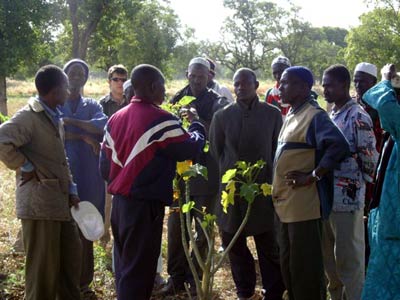 |
|
An Animateur leads a discussion with jatropha
farmers in Dinandougou
© Timothy Singer |
Biofuel firms need to be careful not to threaten fragile water resources and this is seen in the results of the survey. According to the one-source-for-500 people criterion, the farmers scored a high 2.6 out of a possible 3.0 points on the wealth ranking. Yet, by the six to eight families measurement adopted by the company, the farmers scored just 1.2 out of a possible 3.0 points. This is significant because the greatest percentage of farmers reported limited water as the greatest challenge to production, clearly showing that the available sources are not sufficient. On-farm water sources were also evaluated. In Koulikoro, farmers relied nearly entirely on rain as their source of irrigation for their fields, with a score of 0.5 out of a possible 3.0 points for water technology across all communes.
The long term impacts of biofuel production: an opportunity for collaboration
The ten sectors evaluated in the socio-economic baseline survey highlight the need for biofuel firms to respect and understand the true livelihood circumstances of the farmers and their communities. Key findings such as a rate of 75 per cent food insecurity and the challenges of limited tools and water access provide Mali Biocarburant, in this case, with an opportunity to make strategic investments in jatropha production that can immediately help address important socio-economic disparities faced by their farmer partners. These findings also provide the company with an opportunity to build relationships with their farmers and local leaders to address issues of development that fall outside of the direct purview of the company but remain central to breaking the poverty trap for the people of Koulikoro.
Understanding the true severity of the challenges faced by farmers in Koulikoro allows companies such as Mali Biocarburant to design programmes for collaboration that hopefully respect these challenges and encourage farmers to participate by building farmer capacity over time. Even as start-ups, biofuel firms in Africa do not bear the greatest risks of their ventures. Rather, these risks are shouldered by the farmers and communities who will produce feedstock. Developing mutual understanding by undertaking the kind of research described in this article is one way that firms can create synergy between fuel and people, shifting the dynamic from exploitative extraction to socio-economic investment.
Acknowledgements
The authors wish to thank the Mali Biocarburant SA, its CEO Hugo Verkuijl and the Animateurs for their assistance in making this project possible.
Further information
Timothy Singer. Email: timothygsinger@gmail.com.
Matt Basinger, Columbia University - Mechanical Engineering, 500 W 120th St, MC4703, Room 200 Mudd Bldg, New York, NY 10027, USA. Email: mattbasinger@gmail.com.